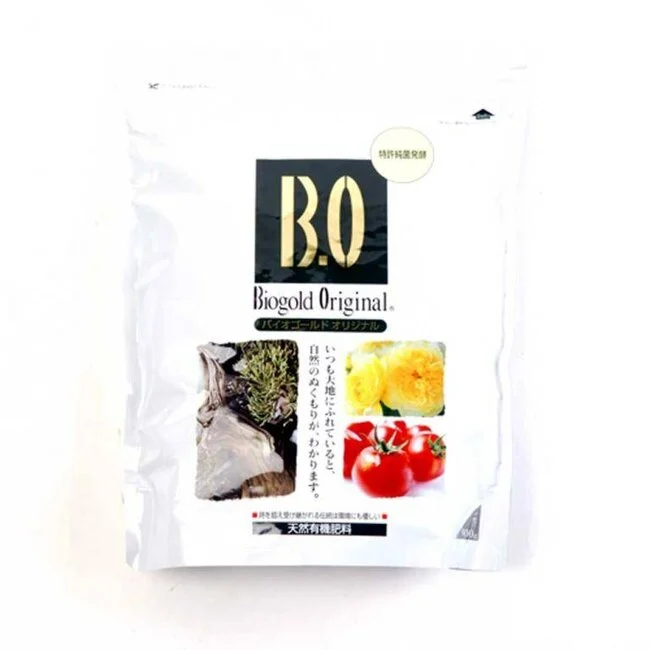 Many bonsai enthusiasts pay too little attention to the fertilization of their bonsai. However, it is important that every tree receives sufficient and timely nutrition. Especially because we make our soil mixes very permeable and poor in nutrients. Therefore, thorough fertilization becomes very important.
Many bonsai enthusiasts pay too little attention to the fertilization of their bonsai. However, it is important that every tree receives sufficient and timely nutrition. Especially because we make our soil mixes very permeable and poor in nutrients. Therefore, thorough fertilization becomes very important.
Outdoor Bonsai
- Preferably use organic solid fertilizer.
- Benefits:
- Easy to dose.
- Contains microorganisms that slowly break down nutrients and release substances absorbable by the roots.
- Contains little or no salts and is safe even with slight overdosage.
- Examples:
- Bio-gold 5.5-6.5-3.5
- Green King 6-5-2
- Sumo C2 Balance 5.5-6.5-3.5 (French organic fertilizer)
- Tibolar RS 4-6-2
- Large cans from Japan with large round pellets
Preference for Bio-gold
- Odorless and contains no larvae of pesky flies or other insects.
- Pellets release nutrients when watering and are easy to dose.
- Contains essential trace elements needed for healthy growth.
- Use fertilizer baskets on a sloped soil surface.
- Replace pellets after six weeks.
- Foliar feeding: monthly solution of 3 Bio-gold pellets/liter water as a growth stimulator.
- Alternatives: Foliaere Green Power, PK from Matsu, Bio-gold Vital.
Fertilizer Formulas
- Formula: N3-P5-K2 + MgO
- Trace elements: B, Cu, Fe, Mn, Zn, Co, Mo
Trial with Green King (2021)
- Smaller pellets for better distribution and more even root growth.
- Alternative: grind fertilizer fine for even better distribution, but faster transfer to roots with watering.
- Slow release of nutrients is important for even root growth.
When to Start Fertilizing
- Deciduous Trees: start when buds begin to open. Wait until at least 20% of the leaves are mature (usually from March/April).
- Conifers: when new growth is visible (usually March/April).
Trees with Special Needs: Pinus
- Young Growing Plants: provide sufficient fertilizer from February to autumn.
- Mature Bonsai:
- Early in the year (from February): mixture with fish and/or blood meal (nitrogen 13-0-0) for bud formation and biological activity.
- End of April: switch to light organic fertilizer (e.g., Bio-gold or Tibolar in small doses).
- From September/October: new needles are mature, give fish and blood meal and from mid to late October (depending on weather conditions) switch to 0-10-10 for winter hardiness.
Elements in Fertilizer
- Nitrogen (N): essential for chlorophyll and protein building blocks, promotes overall growth. Deficiency leads to poor growth and light yellow leaf discoloration. Solution: water with blood meal solution.
- Phosphorus (P): needed for energy metabolism, development of flowers and fruit setting. Deficiency leads to thin growth and poor root development. Solution: fertilizer with higher phosphorus value.
- Potassium (K): important for metabolic processes and winter hardiness. Deficiency leads to yellow or brown leaves between the veins. Solution: add potassium or switch to fertilizer with more potassium.
- Calcium (Ca): needed for cell building and multiplication, positive for soil structure. Deficiency leads to weak growth and disease resistance.
- Magnesium (Mg): essential for photosynthesis. Deficiency leads to yellow edges on older leaves. Solution: magnesium-containing fertilizer.
- Manganese (Mn): deficiency leads to yellow leaves between the veins. Solution: add manganese.
- Trace elements: Boron (B), Copper (Cu), Iron (Fe), Manganese (Mn), Zinc (Zn), Cobalt (Co), Molybdenum (Mo) are usually present in small amounts in soil mixes or fertilizer mixes.
- Iron (Fe): deficiency leads to discolored leaves between the veins. Solution: add peat to lower pH.
Experimental Fertilizers
- Chelal-Gamma: products with chelated trace elements.
- DCM-Mix 2: 7-6-12 + 4 MgO
- Osmocote: with high nitrogen values, mainly for growing trees.
Fertilizer Baskets
- Prevent fertilizer pellets from rolling off the soil surface when watering.
- Use sisal twine around the contours of the pots to prevent pellets from washing away and to help water penetrate the surface better.
